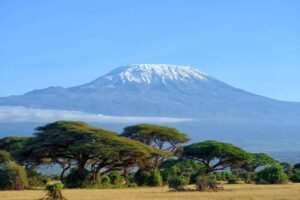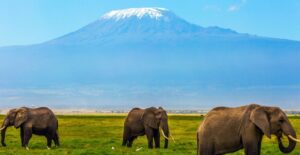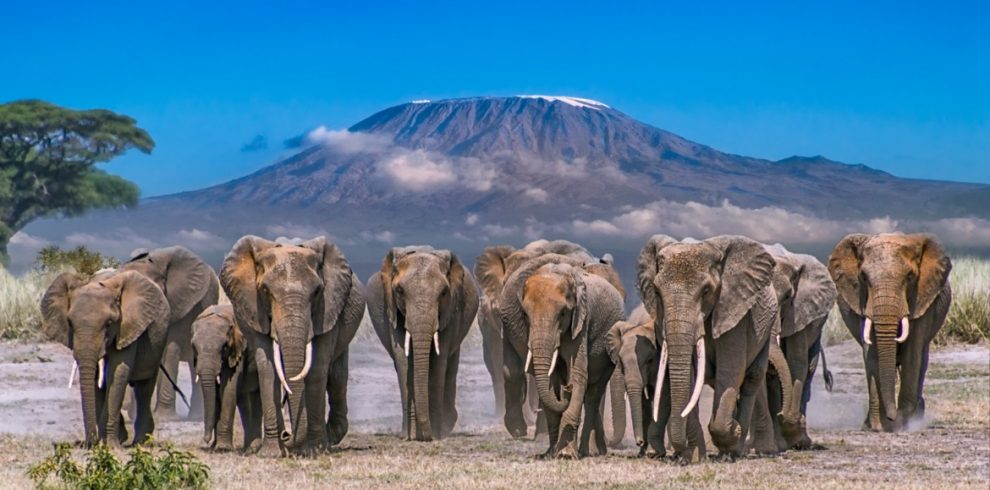Amboseli: Photography Tips with Mt. Kilimanjaro in the Background
Of all the world’s great photographic stages, few can rival the breathtaking canvas of Amboseli National Park. Here, under the vast African sky, the elements converge to create a photographer’s paradise: the timeless, snow-capped peak of Mount Kilimanjaro, vast golden plains that stretch to the horizon, and the majestic elephants that roam them. Capturing this trifecta—wildlife, landscape, and light—in a single frame is the ultimate safari photography goal. Amboseli is not just a destination; it is where you come to create the iconic imagery that defines the very soul of East Africa. Book a trip to amboseli

Why Amboseli is Perfect for Photography
Amboseli’s magic lies in its simplicity and grandeur. Unlike denser bushlands, its open savannahs and swamps provide unobstructed sightlines, allowing you to compose clean, powerful shots. The park’s star subjects—large, relaxed herds of elephants—are incredibly photogenic and often visible as impressive silhouettes against the horizon. But the true crown jewel is the backdrop itself. Mount Kilimanjaro, Africa’s highest peak, provides a scale and drama unmatched by any other wildlife destination, especially during the clear skies of sunrise and sunset when the light transforms the scene into something truly ethereal. Book a trip to amboseli

Understanding the Light in Amboseli
Light is your most crucial tool. The golden hours—the first hour after sunrise and the last hour before sunset—are sacrosanct. During this time, the sun casts a warm, soft, directional light that adds depth, texture, and a magical glow to your subjects, while elongating shadows for dramatic effect. Mornings are particularly special, as the air is often clear of dust, offering the sharpest views of Kilimanjaro before clouds typically form. Midday presents challenges with harsh overhead light and heat haze, but it’s a good time to focus on details, black-and-white conversions, or resting animals in the swamps. Embrace the entire day; a sudden storm can break for a dramatic shaft of light, creating a once-in-a-lifetime shot. Book a trip to amboseli

Photographing Elephants with Kilimanjaro
This is the shot you came for. Patience is key. Work with your guide to position your vehicle so that the mountain is behind the herd. Use a medium telephoto lens (around 200-400mm) to compress the scene, making the mountain appear larger and closer to the elephants than it actually is, emphasizing the scale. Don’t just wait for the perfect line; tell a story. Capture the dynamics: a matriarch leading her family, calves playing in the dust, or the incredible sight of a hundred elephants moving as one. Shoot in continuous mode to capture the motion of swinging trunks and kicked-up dust.

Kilimanjaro as a Backdrop
To do the mountain justice, you need to think like a landscape photographer. Mornings are king for clarity. Compose your shot carefully. Use the rule of thirds, placing the horizon on the lower third line with Kilimanjaro dominating the top of the frame. Use foreground interest to add depth and scale—a lone acacia tree, a grazing zebra, or a line of elephants. For a truly unique perspective, try a wide-angle lens with an elephant or a Maasai warrior in the foreground, making them part of an immense, sweeping landscape. Book a trip to amboseli

Essential Camera Gear for Amboseli
-
Camera Body: A DSLR or mirrorless camera with fast and accurate autofocus is essential for capturing moving animals.
-
Lenses:
-
Telephoto Zoom (100-400mm, 200-600mm): Your workhorse lens for isolating wildlife and compressing the background.
-
Wide-Angle (16-35mm): Essential for capturing the vast landscapes and environmental portraits.
-
Prime Lens (e.g., 300mm f/2.8, 500mm f/4): Ideal for low-light situations (dawn/dusk) and achieving beautifully blurred backgrounds.
-
-
Support: A beanbag is far more practical than a tripod for stabilizing your camera on the roof of a safari vehicle. Bring a sturdy tripod if you plan on astrophotography from your lodge.
-
Extras: Multiple memory cards, extra batteries, a rocket blower for dust, and a rain cover for your gear are non-negotiable. Book a trip to amboseli
Composition Techniques for Iconic Shots
Move beyond centering your subject.
-
Leading Lines: Use animal tracks, roads, or the lines of a herd to lead the viewer’s eye into the image, towards Kilimanjaro.
-
Framing: Use the branches of an acacia tree to frame the mountain or a family of elephants.
-
Negative Space: The vast sky and plains are powerful compositional tools. Placing a single elephant or tree against this emptiness can create a minimalist and powerful image.
-
Silhouettes: At sunset, position yourself to capture the dark, dramatic shapes of elephants or acacias against a brilliantly colored sky.
- Book a trip to amboseli
Capturing Amboseli’s Diversity Beyond Elephants
While the elephants are the headline act, don’t forget the supporting cast. The swamps are a bird photographer’s dream, teeming with flamingos, pelicans, and majestic fish eagles. Capture lions surveying their domain or cheetahs on the hunt in the beautiful golden light. The Maasai people, with their vibrant red shukas and beaded jewelry, set against the Amboseli landscape, offer profound opportunities for powerful portraiture and cultural storytelling.
Drone Photography in Amboseli
It is critical to note that the use of drones is strictly prohibited within Kenyan national parks, including Amboseli, without a hard-to-obtain permit from the Kenya Civil Aviation Authority and Kenya Wildlife Service. The noise stressess wildlife and disturbs the safari experience for others. Respect these regulations. Instead, seek out high vantage points from your vehicle or lodge for a elevated perspective.
Editing Tips for Amboseli Photos
Post-processing is where you bring your vision to life.
-
Enhance Colors: Carefully boost the vibrancy and saturation to reflect the rich golden hues of the savannah and the deep blues of the sky without making it look artificial.
-
Adjust Light: Use gradient filters to balance the exposure between a bright sky and a darker foreground. Recover details in the highlights of clouds and the shadows of elephants.
-
Sharpening: Apply selective sharpening to your main subject to make it pop.
-
Crop for Impact: Use cropping to refine your composition, strengthen the rule of thirds, or create a more panoramic feel.
- Book a trip to amboseli
Best Time of Year for Amboseli Photography
-
Dry Season (June-October): This is the prime time. Skies are clearer, animals congregate around water sources, and dust can add atmosphere to your shots. Elephant viewing is at its most reliable.
-
Wet Season (November-May): The landscape is lush and green, dramatic storm clouds add mood to your images, and it’s bird nesting season. The trade-off is that Kilimanjaro is often shrouded in clouds for much of the day.
- Book a trip to amboseli
Practical Safari Photography Tips
-
Be Ready: Your camera should be on, with the right settings, and in your hand at all times. The best action happens in a flash.
-
Patience Pays Off: Wait for the animals to move into the perfect position. The best photographers are the most patient ones.
-
Respect the Wildlife: Always follow your guide’s instructions. Do not pressure them to get too close for a shot. Ethical photography prioritizes the welfare of the subject.
Iconic Shots Every Photographer Should Capture
-
The classic: A long line of elephants walking toward Kilimanjaro.
-
An intimate close-up of a calf under its mother’s protection.
-
A lone acacia tree silhouetted against a fiery Kilimanjaro sunset.
-
A bull elephant kicking up red dust in the golden hour light.
-
A Maasai elder standing proudly against the mountain.
Common Mistakes to Avoid
-
Shooting in Auto: Take control of your settings, especially aperture and shutter speed.
-
Centering Every Subject: Experiment with composition.
-
Only Using a Long Lens: You’ll miss the grandeur of the landscape. Switch to a wide-angle to establish the scene.
-
Forgetting the Background: A cluttered background can ruin a great wildlife shot. Always check what’s behind your subject.
FAQs
-
What camera settings work best? For moving elephants, use Shutter Priority (Tv/S) with a speed of at least 1/1000s. For landscapes, use Aperture Priority (Av/A) at f/8-f/11.
-
How often is Kilimanjaro visible? Most clearly in the early mornings, especially during the dry season. Clouds often build by midday.
-
Do I need professional equipment? No. A advanced bridge camera with a good zoom can also capture amazing images. It’s more about knowledge and being in the right place than the gear.
-
Is drone photography allowed? Generally, no. It is prohibited in national parks.
-
What’s the best lens? A 100-400mm or 200-500mm zoom lens offers the most versatility.
Conclusion
Amboseli is a gift to photographers. It challenges you, inspires you, and rewards you with frames that will become treasured heirlooms. It’s where technical skill meets artistic vision, all set against one of the most dramatic backdrops on Earth. The images you take home will be more than pictures; they will be sensory portals back to the dust, the golden light, and the profound silence of the African plains. Book a trip to amboseli
Ready to frame your own iconic Amboseli masterpiece? Join a Woodsy Adventures photography safari led by expert guides who are as passionate about light and composition as they are about wildlife. They know precisely where and when to position you for the perfect shot. Book your Amboseli Photo Safari with Woodsy Adventures today and capture the soul of Africa through your lens. Book a trip to amboseli




